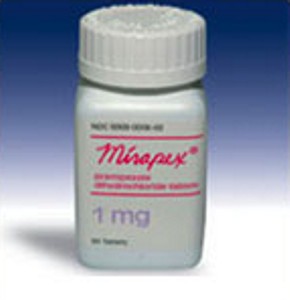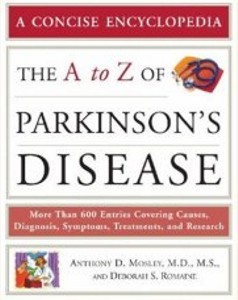30th July 2007 : New research
The assessment of Mirapex�
(a dopamine agonist)���
Neuroscience and Behavioral
Physiology [2007] 37 (6) : 539-546 (Fedorova NV, Chigir' IP.)
Complete
abstract
 Mirapex is a dopamine agonist
that has been used for the treatment of Parkinson's Disease. A review of the
medical literature concerning dopamine agonists was carried out a alongside an
assessment of Mirapex concerning its efficacy in Parkinson's Disease.
Improvements were demonstrated in
general state, motor activity, daily activities, and the quality of life. There
was a decrease in the severity of motor fluctuations and dyskinesias and in
anxiety and depression, and to improvements in cognitive functions.
The conclusions were that
Mirapex was effective and well tolerated. However, the study was not long term.
Mirapex is a dopamine agonist. The long term use of dopamine agonists is known
to make the dopamine receptors less sensitive. This is the exact opposite effect
of what is intended when dopamine agonists are used. For more information on
Mirapex
Mirapex is a dopamine agonist
that has been used for the treatment of Parkinson's Disease. A review of the
medical literature concerning dopamine agonists was carried out a alongside an
assessment of Mirapex concerning its efficacy in Parkinson's Disease.
Improvements were demonstrated in
general state, motor activity, daily activities, and the quality of life. There
was a decrease in the severity of motor fluctuations and dyskinesias and in
anxiety and depression, and to improvements in cognitive functions.
The conclusions were that
Mirapex was effective and well tolerated. However, the study was not long term.
Mirapex is a dopamine agonist. The long term use of dopamine agonists is known
to make the dopamine receptors less sensitive. This is the exact opposite effect
of what is intended when dopamine agonists are used. For more information on
Mirapex
�
28th July 2007 : New research
The newly discovered cause of Dyskinesia����
Brain [2007] 130 (Pt 7) :
1819-1833 (Carta M, Carlsson T, Kirik D, Bjorklund A.)
Complete
abstract
In patients with Parkinson's
disease, the therapeutic efficacy of L-DOPA medication is gradually lost over
time, and abnormal involuntary movements, dyskinesias, gradually emerge as a
prominent side-effect in response to previously beneficial doses of the drug.
Dyskinesia was thought to be due to too much L-dopa. However, this study showed
that it is a combination of L-dopa and too much serotonin that leads to
dyskinesia. They did this by blocking the formation of serotonin. Dyskinesia
came to a halt. Drugs that could lower serotonin levels could therefore rid
dyskinesia without reducing the beneficial effect of L-dopa. People produce more
serotonin when they lack sleep, because serotonin is what makes people sleep.
Therefore, sleeping more may reduce serotonin levels and thereby lower
somebody's likelihood to develop dyskinesia.
��������
14th July 2007 : New
research
Bright light therapy
reduces Parkinson's Disease�symptoms
Chronobiology International
[2007] 24 (3) :521-537 (Willis GL, Turner EJ.)
Complete
abstract
The objective of this study was
to administer Light Therapy to Parkinson's Disease patients and observe the
effects. Each patient was exposed to white fluorescent light for over an hour
prior to the usual time that they went to sleep. Within two weeks, there was
marked improvement in bradykinesia and rigidity in most patients. Tremor was not
affected. Agitation, dyskinaesia, and psychiatric side effects were reduced.
 Elevated mood, improved sleep, decreased seborrhea, reduced impotence, and
increased appetite were also observed. There was a reduction of the dose of
Parkinson's Disease drugs in some patients by up to 50% without loss of symptom
control. Factors limiting the efficacy of Light Therapy included multiple
disease states, emotional stress, treatment compliance, polypharmacy, advanced
age, and predominance of positive symptoms. It's assumed that the effect would
only occur on the days it is used. Light suppresses melatonin formation, which
in turn lowers dopamine activity. As a lack of dopamine causes Parkinson's
Disease, light is used to suppress the interfering effect of melatonin. For more
information on
Bright light therapy
Elevated mood, improved sleep, decreased seborrhea, reduced impotence, and
increased appetite were also observed. There was a reduction of the dose of
Parkinson's Disease drugs in some patients by up to 50% without loss of symptom
control. Factors limiting the efficacy of Light Therapy included multiple
disease states, emotional stress, treatment compliance, polypharmacy, advanced
age, and predominance of positive symptoms. It's assumed that the effect would
only occur on the days it is used. Light suppresses melatonin formation, which
in turn lowers dopamine activity. As a lack of dopamine causes Parkinson's
Disease, light is used to suppress the interfering effect of melatonin. For more
information on
Bright light therapy
�
13th
July 2007 : New research
DOES SMOKING REALLY REDUCE PARKINSON'S
DISEASE ?
Archives of Neurology [2007] 64
(7) : 990-997 (Ritz B, Ascherio A, Checkoway H, Marder KS, Nelson LM, Rocca WA,
Ross GW, Strickland D, Van Den Eeden SK, Gorell J.)
�
Complete
abstract
 Smoking has long been thought to
lessen the likelihood of Parkinson's Disease.
However, questions remained
regarding the effect of age at smoking onset, time since quitting, and
race/ethnicity that have not been addressed due to sample size constraints. This
study analyses�
a lot of previous research.
An inverse relationship between
smoking and Parkinson's Disease was confirmed. The lessening effect of smoking
was greater in current smokers rather than past smokers. The effect was found to
be dependent on the amount of cigarettes smoked. Reduced likelihood was observed
for white and Asian patients, but was not seen in Hispanic and African American
patients. They also found an inverse association both for smoking cigars or
pipes and for chewing tobacco in male subjects. Importantly, effects seemed not
to be influenced by sex or education. Differences observed by race and age at
diagnosis warranted further study. However, what's better - Parkinson's Disease
or Lung Cancer ?
Smoking has long been thought to
lessen the likelihood of Parkinson's Disease.
However, questions remained
regarding the effect of age at smoking onset, time since quitting, and
race/ethnicity that have not been addressed due to sample size constraints. This
study analyses�
a lot of previous research.
An inverse relationship between
smoking and Parkinson's Disease was confirmed. The lessening effect of smoking
was greater in current smokers rather than past smokers. The effect was found to
be dependent on the amount of cigarettes smoked. Reduced likelihood was observed
for white and Asian patients, but was not seen in Hispanic and African American
patients. They also found an inverse association both for smoking cigars or
pipes and for chewing tobacco in male subjects. Importantly, effects seemed not
to be influenced by sex or education. Differences observed by race and age at
diagnosis warranted further study. However, what's better - Parkinson's Disease
or Lung Cancer ?
�
2nd
July 2007 : New research
ENVIRONMENTAL RISK FACTORS FOR TREMOR
European Neurology [2007] 58 (2) : 106-113
(Jimenez-Jimenez FJ, de Toledo-Heras M, Alonso-Navarro H, Ayuso-Peralta L,
Arevalo-Serrano J, Ballesteros-Barranco A, Puertas I, Jabbour-Wadih T,
Barcenilla B.)
Complete
abstract
This
study examined the role of environment in the risk of essential tremor. People
were assessed for family history of tremor, exposure to environmental products
containing lead, mercury, manganese, solvents and beta-carbolines,
and exposure to agricultural work, well water, pesticides, and cigarette smoking
and alcohol consumption.
 Family history of tremor and exposure to agricultural
work, pesticides, smelting, frosted glass, paintings, wheat, corn, and barley
were more frequent in people with tremor. In a more extensive assessment, only
family history of tremor and exposure to agricultural work and frosted glass
remained significant. Time of exposure to agricultural work, wheat and barley
was higher in people with tremor. Age at onset of tremor was lower in people
with a family history of tremor and higher in patients exposed to iron-manganese
alloys and alcohol. Time of exposure, but not total consumption of alcohol and
cigarettes, was correlated with age at onset of tremor.
Family history of tremor and exposure to agricultural
work, pesticides, smelting, frosted glass, paintings, wheat, corn, and barley
were more frequent in people with tremor. In a more extensive assessment, only
family history of tremor and exposure to agricultural work and frosted glass
remained significant. Time of exposure to agricultural work, wheat and barley
was higher in people with tremor. Age at onset of tremor was lower in people
with a family history of tremor and higher in patients exposed to iron-manganese
alloys and alcohol. Time of exposure, but not total consumption of alcohol and
cigarettes, was correlated with age at onset of tremor.
�
2nd
July 2007 : New book
The A TO Z OF PARKINSON'S DISEASE
Anthony D.Mosley, Deborah S.Romaine
 "The A to Z of Parkinson's Disease"
presents the most current information pertaining to the complex issues and
news-making topics relating to this disease, including etiology, symptoms,
treatments, medications, surgeries, research, medical terms, coping and
caregiving, living with Parkinson's disease, and much more. More than 600
accessible entries cover aspects of the medical, scientific, social, and
lifestyle implications of Parkinson's disease. Appendixes include an extensive
bibliography, a directory of key support groups and organizations, a glossary,
and other valuable resources. For more information go to
Book details
"The A to Z of Parkinson's Disease"
presents the most current information pertaining to the complex issues and
news-making topics relating to this disease, including etiology, symptoms,
treatments, medications, surgeries, research, medical terms, coping and
caregiving, living with Parkinson's disease, and much more. More than 600
accessible entries cover aspects of the medical, scientific, social, and
lifestyle implications of Parkinson's disease. Appendixes include an extensive
bibliography, a directory of key support groups and organizations, a glossary,
and other valuable resources. For more information go to
Book details
�
ARCHIVES :
�
Current�December
2008
November 2008
October 2008
September 2008
August 2008
July 2008
June
2008
May 2008
April 2008
March 2008� �February
2008
.gif)
.gif)
 Mirapex is a dopamine agonist
that has been used for the treatment of Parkinson's Disease. A review of the
medical literature concerning dopamine agonists was carried out a alongside an
assessment of Mirapex concerning its efficacy in Parkinson's Disease.
Mirapex is a dopamine agonist
that has been used for the treatment of Parkinson's Disease. A review of the
medical literature concerning dopamine agonists was carried out a alongside an
assessment of Mirapex concerning its efficacy in Parkinson's Disease.
 Elevated mood, improved sleep, decreased seborrhea, reduced impotence, and
increased appetite were also observed. There was a reduction of the dose of
Parkinson's Disease drugs in some patients by up to 50% without loss of symptom
control. Factors limiting the efficacy of Light Therapy included multiple
disease states, emotional stress, treatment compliance, polypharmacy, advanced
age, and predominance of positive symptoms. It's assumed that the effect would
only occur on the days it is used. Light suppresses melatonin formation, which
in turn lowers dopamine activity. As a lack of dopamine causes Parkinson's
Disease, light is used to suppress the interfering effect of melatonin. For more
information on
Elevated mood, improved sleep, decreased seborrhea, reduced impotence, and
increased appetite were also observed. There was a reduction of the dose of
Parkinson's Disease drugs in some patients by up to 50% without loss of symptom
control. Factors limiting the efficacy of Light Therapy included multiple
disease states, emotional stress, treatment compliance, polypharmacy, advanced
age, and predominance of positive symptoms. It's assumed that the effect would
only occur on the days it is used. Light suppresses melatonin formation, which
in turn lowers dopamine activity. As a lack of dopamine causes Parkinson's
Disease, light is used to suppress the interfering effect of melatonin. For more
information on

 Family history of tremor and exposure to agricultural
work, pesticides, smelting, frosted glass, paintings, wheat, corn, and barley
were more frequent in people with tremor. In a more extensive assessment, only
family history of tremor and exposure to agricultural work and frosted glass
remained significant. Time of exposure to agricultural work, wheat and barley
was higher in people with tremor. Age at onset of tremor was lower in people
with a family history of tremor and higher in patients exposed to iron-manganese
alloys and alcohol. Time of exposure, but not total consumption of alcohol and
cigarettes, was correlated with age at onset of tremor.
Family history of tremor and exposure to agricultural
work, pesticides, smelting, frosted glass, paintings, wheat, corn, and barley
were more frequent in people with tremor. In a more extensive assessment, only
family history of tremor and exposure to agricultural work and frosted glass
remained significant. Time of exposure to agricultural work, wheat and barley
was higher in people with tremor. Age at onset of tremor was lower in people
with a family history of tremor and higher in patients exposed to iron-manganese
alloys and alcohol. Time of exposure, but not total consumption of alcohol and
cigarettes, was correlated with age at onset of tremor.  "The A to Z of Parkinson's Disease"
presents the most current information pertaining to the complex issues and
news-making topics relating to this disease, including etiology, symptoms,
treatments, medications, surgeries, research, medical terms, coping and
caregiving, living with Parkinson's disease, and much more. More than 600
accessible entries cover aspects of the medical, scientific, social, and
lifestyle implications of Parkinson's disease. Appendixes include an extensive
bibliography, a directory of key support groups and organizations, a glossary,
and other valuable resources. For more information go to
"The A to Z of Parkinson's Disease"
presents the most current information pertaining to the complex issues and
news-making topics relating to this disease, including etiology, symptoms,
treatments, medications, surgeries, research, medical terms, coping and
caregiving, living with Parkinson's disease, and much more. More than 600
accessible entries cover aspects of the medical, scientific, social, and
lifestyle implications of Parkinson's disease. Appendixes include an extensive
bibliography, a directory of key support groups and organizations, a glossary,
and other valuable resources. For more information go to